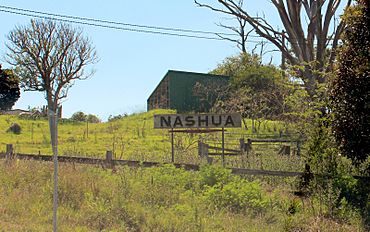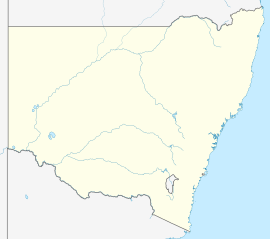Nashua, New South Wales facts for kids
Quick facts for kids NashuaNew South Wales |
|||||||||
|---|---|---|---|---|---|---|---|---|---|

old railway sign
|
|||||||||
| Population | 238 (2016 census) | ||||||||
| Postcode(s) | 2479 | ||||||||
| State electorate(s) | Ballina | ||||||||
| Federal Division(s) | Richmond | ||||||||
|
|||||||||
Nashua is a small area in the north-east of New South Wales, Australia. It's located between the towns of Lismore and Byron Bay. Nashua used to have a railway station, but it's no longer there.
The Story Behind the Name
Nashua was first called Springvale. But two brothers, James and John Toohey, owned a large property there. They decided to name their property Nashua.
The name "Nashua" comes from the Nashaway American Indians. It means "land between two rivers" or "river with a pebbled bottom." It's a bit of a mystery why the Irish Toohey brothers chose this Native American name for their land.
The Tooheys originally planned to grow sugar cane on their property. However, the cold weather (frost) ruined their crops. Today, the rolling hills around Nashua are used for different types of farming. You'll find dairy farms, pecan nut trees, and other crops growing there. The government later used the name Nashua for the local railway station, and the name has stuck ever since.
Buildings and the Railway
Over the years, many of Nashua's original buildings have disappeared. The Nashua Hall was built in 1909. It cost £149 10 shillings to build, which was a lot of money back then! Sadly, a big storm destroyed the hall in 1942, and it was never rebuilt.
Other important places like the "Flower of the Forest" hotel, the local school, and the General Store are also gone. The hotel was very popular when the railway line was being built. The Ballina-Booyong railway line opened in 1930. But floods caused a lot of damage in 1948, and the line officially closed in 1953.
Nature and the Land
Before European settlement, the Nashua area was covered in thick subtropical rainforest. This forest was part of the traditional lands of the Bundjalung nation. Much of this huge forest, known as the Big Scrub, was cleared in the late 1800s.
You can still see a small part of the original forest at the nearby Booyong Flora Reserve. The soil in Nashua is a reddish-brown color. This special soil comes from ancient lava flows from Mount Warning and later volcanic activity from the Nightcap Range. The area gets a good amount of rain each year. For example, Lismore receives about 1340 millimeters of rain, and Byron Bay gets around 1733 millimeters.


